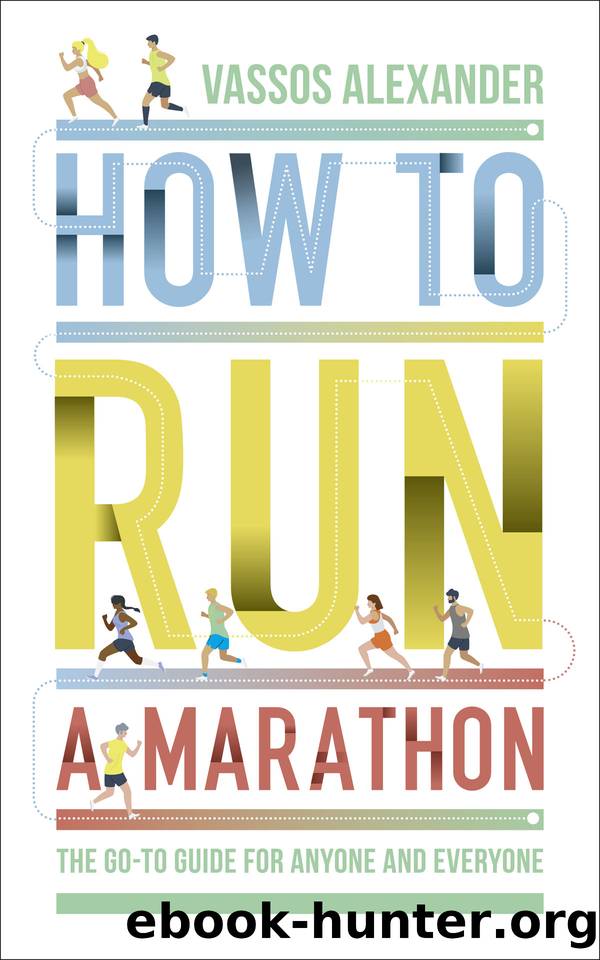How to Run a Marathon by Vassos Alexander

Author:Vassos Alexander [Alexander, Vassos]
Language: eng
Format: epub
Publisher: HarperCollins Publishers
Published: 2020-01-15T00:00:00+00:00
WHAT TO REMEMBER
Stretch after â not before â a run;
Each stretch should be 30 seconds-plus;
Calf, hip flexors and glutes are equally important, probably even more so, than hamstrings and quads.
INJURY
Tip: Beach running strengthens your feet and ankles.
Itâs a day Iâll never forget. Six months or so after I first got into running and Iâve gone from being unable to make it to the end of my street to entering my first half-marathon. My confidence is growing. Spiralling, you might say.
I go out for a run, heading straight for the river as usual. After half a mile, just as I reach the water and join the Thames towpath opposite Fulhamâs famous football ground, Craven Cottage, the outside of my left knee starts grating. Itâs painful, but this has happened before so I donât fret unduly. I know that within five minutes or so the pain will recede and Iâll continue merrily along my way down the river.
Only this time, the pain doesnât go away. I wait patiently, running slower, giving it every chance. But instead of receding like it always has done, it swells somewhat alarmingly. I stop and rub the offending knee. Start running again. But the outside of the knee keeps grinding away, more than annoying now. This is proper pain. I stop, unsure what to do.
Is this what an injury feels like?
I limp home disconsolately. A local physio diagnoses runnerâs knee, or iliotibial band syndrome (ITBS). Itâs an overuse injury of the tissues on the outer part of thigh that connect the knee with the hip. He advises strengthening exercises and a lengthy rest from running.
I donât like the physioâs diagnosis and go to see a top sports doctor. Simon Kemp puts the worldâs best rugby players back together ⦠Surely heâll have a magic bullet for an amateur runnerâs hurty left knee? He doesnât. Instead he sets me on the road to rest and rehab with some wise words about running too much, too quickly. Many people could easily manage a half-marathon within six months of starting to run but not, it seems, me.
The rule of thumb is to increase training time and volume by no more than 10 per cent every week. So, if you ran 10 miles last week, with your longest run being five, then this week, you shouldnât do more than 11 miles in total, with your long run being a maximum of five and a half miles.
Itâs helpful to categorise runners into red, amber or green risk categories. Both their initial running loads and first running goal need to be proportionate to where they are starting from. And really, the approach for each of these three groups needs to be different.
Green is: Iâve always been a regular runner. I may have lapsed for a little while, but I ran at school and/or university and I havenât had long periods of not running.
Amber is: Iâve run on and off, Iâve done other sports, Iâve remained fit and active. Maybe Iâve not been running
Download
This site does not store any files on its server. We only index and link to content provided by other sites. Please contact the content providers to delete copyright contents if any and email us, we'll remove relevant links or contents immediately.
Shoe Dog by Phil Knight(4169)
The Rules Do Not Apply by Ariel Levy(3906)
Walking by Henry David Thoreau(3235)
Running Barefoot by Amy Harmon(3058)
Crazy Is My Superpower by A.J. Mendez Brooks(2861)
How to Read Water: Clues and Patterns from Puddles to the Sea (Natural Navigation) by Tristan Gooley(2856)
I'll Give You the Sun by Jandy Nelson(2842)
How to Read Nature by Tristan Gooley(2666)
How Music Works by David Byrne(2527)
The Boy, the Mole, the Fox and the Horse by Charlie Mackesy(2453)
Seducing Cinderella by Gina L. Maxwell(2235)
Cuba by Lonely Planet(2185)
The Fight by Norman Mailer(2159)
Going Long by Editors of Runner's World(1922)
Accepted by Pat Patterson(1917)
The Unfettered Mind: Writings from a Zen Master to a Master Swordsman by Takuan Soho(1859)
The Happy Runner by David Roche(1823)
Backpacker the Complete Guide to Backpacking by Backpacker Magazine(1815)
Trail Magic by Trevelyan Quest Edwards & Hazel Edwards(1760)
